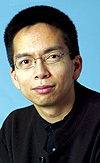We live in a world where scientists are supposed to be shabby nerds, fussy, anti-social lab rats; while artists carry the image of the 70’s hippies, socialites, talkative/argumentative, colourfully dressed, outgoing people of many talents.


We live in a world where scientists are supposed to be shabby nerds, fussy, anti-social lab rats; while artists carry the image of the 70’s hippies, socialites, talkative/argumentative, colourfully dressed, outgoing people of many talents.
Many people struggle to satisfy these social stigmas and forget to do the things that they yearn for in life. These are just stigmas! Artists observe the reality in their surroundings and express them in music, art, and dance etc.
Scientists seek to explain the logic behind the reality. Vladimir Nabokov, one of the most famous artists; the novelist, once put it, "The greater one’s science, the deeper the sense of mystery.” Nabokov is famous in both literature and the science of classification of butterflies.
Neuroscience is one such area where science and art compliment each other. The science of nerves can explain the movement of signals down to the simplest cell of the brain, and how the electrical messages are transmitted from various parts of the body to the brain and back to the body.
But no neuroscientist can explain to you the connection between these electrical messages and the human thoughts that we have. Neuroscience has little to tell us about life itself.
But as Jonah Lehrer puts it in The Future of Science…is Art, the novelist, the painter, and the poet embrace those ephemeral aspects of the mind that cannot be reduced, or dissected, or translated into the activity of an acronym.
They strive to capture life as it’s lived.
Neuroscientist Semir Zeki notes (in the same Seed magazine article), "Artists [painters] are in some sense neurologists, studying the brain with techniques that are unique to them.”
Leonardo Da Vinci’s was a sculptor, painter, architect, musician, anatomist, inventor and mathematician, although we all know him for his famous painting of the smiling woman called, Mona Lisa.
In Bridging art and science through the ages, Gail Cowan writes that Da Vinci’s observations and experiments into the workings of nature include the stratification of rocks, the flow of water, the growth of plants, and the action of light.
Albert Einstein one of the most famous scientists in the world said in 1929, "If I were not a physicist, I would probably be a musician. I often think in music. I live my daydreams in music. I see my life in terms of music ... I get most joy in life out of music.”
The most beautiful thing we can experience is the mysterious. It is the source of all true art and all science. He to whom this emotion is a stranger, who can no longer pause to wonder and stand rapt in awe, is as good as dead: his eyes are closed.”
In a speech by an EU commissioner entitled Creativity and sciences in Arts, it was stated that Art can reveal the beauty of nature - as often discovered by science - from the atomic to the cosmic.
Scientific ideas and their societal impacts can be translated, popularized and filtered through art.
According to John Maeda, winner, in 2001, of both the United States’ National Design Award for Communication Design, and Japan’s Mainichi Design Prize "Amidst all the attention given to the sciences as to how they can lead to the cure of all diseases and daily problems of mankind, I believe that the biggest breakthrough will be the realization that the arts, which are conventionally considered ‘useless,’ will be recognized as the whole reason why we ever try to live longer or live more prosperously. The arts are the science of enjoying life.”
The most surprising connection between arts and sciences lies in the founders of western philosophy, Socrates, Aristotle and Plato, during the renaissance.
They were authorities in a wide a variety of science and arts which include mathematics, logic, music, government, and politics etc.
These points to the fact that knowledge initially was never meant to distinguish between arts and sciences but was rather a creation of convenience or a result of specialization.
And in philosophy itself art and science are constantly playing games. A. Spirkin, In Philosophy and Art, writes "Scientists who lack an aesthetic element in their makeup are dry-as-dust pedants, and artists who have no knowledge of philosophy and science are not very interesting people either, for they have little to offer above elementary common sense.
The true artist, on the other hand, constantly refreshes himself with the discoveries of the sciences and philosophy.
While philosophy and science tend to draw us into "the forest of abstractions”, art smiles upon everything, endowing it with its integrating, colorful imagery”
An essay on science and society in the Science magazine, reads, "the worst and deepest stereotypes drive a particularly strong wedge between art (viewed as an ineffably "creative” activity, based on personal idiosyncrasy and subject only to hermeneutical interpretation) and science (viewed as a universal and rational enterprise, based on factual affirmation and analytical coherence).
It goes on to state that "but we do believe that the common ground of methods for mental creativity and innovation, and the pedagogic virtues of unified nurturing for all varieties of human creativity, should inspire collaboration for mutual reinforcement.”
Contact: kelvion@yahoo.com


